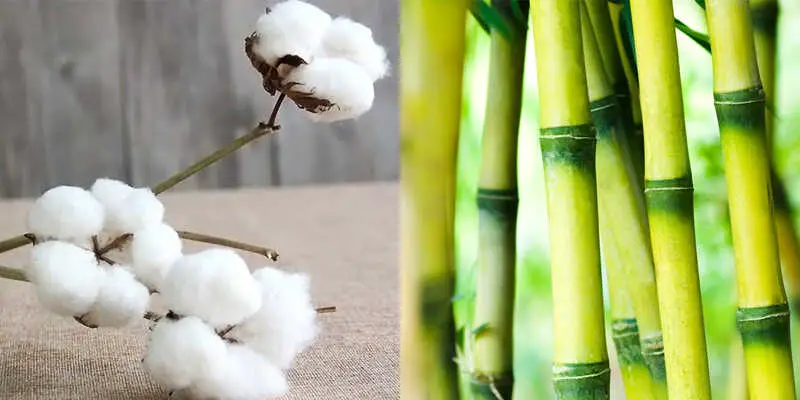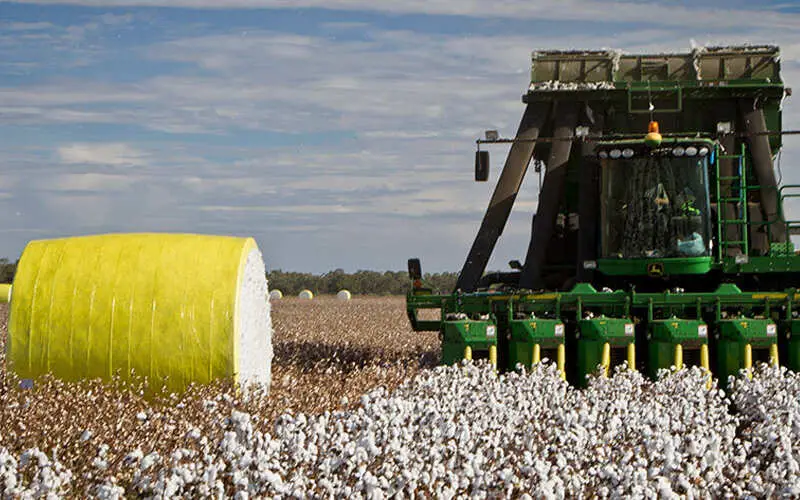Is Bamboo Fabric More Eco-Friendly Than Cotton?
As an Amazon Associate, Ecotero earns from qualifying purchases.
In terms of both popularity and eco-friendliness, bamboo fabric is currently trending ahead of cotton.
Businesses and organizations behind the bamboo trend preach that bamboo fabric is a more eco-friendly alternative to cotton for various of reasons.
However, many people and critics still question the sustainability of bamboo, and whether bamboo fabric is more eco-friendly than cotton.
So to come up with a definitive answer, we will be looking at the six different areas where both bamboo and cotton fabrics have a direct impact to the environment.
Starting from the moment they are cultivated up to the end of their usable lifetime.
So, bamboo vs cotton, which one do you think is “greener” and a more sustainable fabric? Let’s find out.
Bamboo vs Cotton Material Cultivation

Location Requirements
Cotton:
Cultivating cotton requires specific types of soil, the area needs to be cleared, and the land needs to be plowed before the seeds can be planted
The plowing and clearing process are commonly done with machines, and hence, it leaves carbon footprint.
Bamboo:
Bamboo can grow on most types of soil. It usually sprouts on its own without tilling and clearing.
When cultivated for commercial use, bamboo rarely needs much attention and investment.
Care & Maintenance
Cotton:
Common Practice
Cultivating cotton uses approximately 25% of the world’s insecticides and more than 10% of the pesticides.
And according to the USDA (United States Department of Agriculture), cotton is the third most pesticide-sprayed crop, just behind corn and soybeans.
As you may already know, pesticides are known to have negative impacts on the soil and environment.
But it’s worth mentioning that this is not the case when growing “organic cotton.”
Organic Practice
Growing organic cotton utilizes methods that have a low impact on the environment. It is based on crop diversification and the use of non-synthetic pesticides and fertilizers.
Unfortunately, as of 2019, organic cotton only makes up approximately 0.93% of global cotton products due to high cost of production.
Bamboo:
Bamboo is a type of grass, and it can grow without proper care and maintenance.
Water Consumption
Cotton:
Cotton cultivation requires a large amount of water, especially if the land is sandy, and requires supplemental irrigation.
Cultivation of cotton has negative impacts on the ecosystem and contributes to water pollution in cotton-producing countries such as Australia and Pakistan.
Bamboo:
Bamboo requires a minimal water supply to grow and thrive in most environment.
It appears that bamboo is more eco-friendly than cotton when it comes to the overall cultivation process.
But can it hold up its advantage in the following categories?
Sourcing of Raw Materials
Availability
Cotton:
Cotton as a raw material is widely available and produced around the world.
Cotton manufacturers have multiple reliable sources when importing cotton for commercial purposes.
Based on the data from Statista, the top 5 leading cotton-producing countries in 2019 are India, China, United States, Brazil, and Pakistan.
Bamboo:
The bamboos used to produce the most bamboo fabric in the market are sourced from China.
Most businesses all over the world relies on China for supply of bamboo. Which means a lot of raw materials are shipped across the globe leaving a considerable carbon footprint.
Harvesting of Materials
Cotton:
Harvesting cotton in many countries today, such as the USA, is done by machines.

Machines like Cotton Pickers and Cotton Spinners pick the cotton buds from the plants. A Cotton Gin separates cotton fibers from their seeds.
The cotton harvesting process requires burning of fossil fuels to operate the machines.
Bamboo:
Harvesting bamboo is simpler. Typically, it only involves manual labor and can be done by cutting matured bamboos with saw and other sharp tools.
There is also no clearcutting necessary, and there is no need to uproot the entire plant, which helps prevent soil erosion.
Sustainability
Both bamboo and cotton are sources of renewable raw materials for fabric.
However, bamboo is considered by many to be more sustainable, given that:
- Bamboo is one of the fastest-growing plants on the planet
- It can grow and can be cultivated in almost all type of soil
- It doesn’t need much fertilizer and pesticides to grow
- Compared to cotton, bamboo needs less water to thrive
- Cotton needs re-planting to harvest new raw materials, bamboo is a self-replenishing crop
Fabric Manufacturing
Cotton Fabric Manufacturing:
All cotton fabric are produced the same way.
The cotton first needs to go through a machine that separates the seeds, fibers and other debris.
The cotton fibers that are collected will then be sent to a textile mill to be further cleaned by beating and blowing.
A carding machine will then straighten the cleaned fibers and makes them into a soft, untwisted rope called a sliver.

The sliver is then made into yarn, and machines called Looms will weave cotton yarns into cotton fabrics.
The woven cotton fabric, called gray goods, is finally sent to a finishing plant where it is bleached, pre-shrunk, dyed, printed, and treated before being made into a clothing or home product. (source)
Unfortunately, most chemicals and substances used in the final processing of cotton fabric are toxic.
It includes heavy metals, formaldehyde, azo dyes, benzidine, or chlorine bleach that can cause environmental pollution near the textile mill where the waste material is drained.
Furthermore, many of the said chemicals were found as residues in the finished cotton product and are suspected of causing allergies, eczema or even cancer.
Bamboo Fabric Manufacturing:
Bamboo fabric are produced either by a mechanical process or a chemical process.

Mechanical Process
This process involves crushing bamboo with machines and using a natural enzyme to produce a mushy mass.
Bamboo fibers are combed from the mushy mass and are later spun into a yarn.
The mechanical process of producing bamboo fabric is considered eco-friendly because it doesn’t use toxic chemicals that harms the environment.
The resulting fabric is called bamboo linen.
Unfortunately, you almost can’t find bamboo products that are produced using this eco-friendly process because it is expensive, among other intriguing facts.
Chemical Process
One of the disadvantages of bamboo fabric is that most of them are produced using a harsh chemical process.
Bamboo Rayon is produced by dissolving bamboo chunks in a toxic chemical solution to create a pulpy viscose substance.
The pulpy substance is then treated and processed to create a soft and silky bamboo fabric.
And contrary to what most people assumes, bamboo rayon, though it comes from a natural bamboo fiber, is not eco-friendly.
However, Bamboo Lyocell is treated with a different process that uses an organic compound in a closed-loop system that recycle and reuse 99% of the waste.
Durability of the Fabric
A durable fabric will last longer, hence, saving raw materials, water, energy, and other resources required to create the product.
While both bamboo and cotton fabric materials are considered equally durable, bamboo has thicker and stronger fibers.
In particular, the bamboo rayon is three times more durable than cotton fabric.
Fabric Maintenance
Both cotton and bamboo fabrics can be washed and cleaned at home without the need for special detergents or certain water temperatures.
This eliminates the need to use stronger anti-stain detergents that might contain toxic chemicals or heat water when washing.
Allowing consumers to have a more eco-friendly laundry washing.
Cotton vs Bamboo Fabric Biodegradability
Cotton Fabric:
Cotton is a completely biodegradable material.
However, if it is not grown organically and is treated with chemicals, it can become an environmental hazard.
The moment the inorganic cotton fabric biodegrades, the chemicals used to cultivate and treat it will seep down into the soil and might harm the environment.
Bamboo Fabric:
Most bamboo fabric on the market are made with bamboo rayon and according to the FTC (Federal Trade Commissions)…
Products made of rayon are not biodegradable because they will not break down in a reasonably short time after customary disposal.
However, bamboo lyocell and bamboo linen are considered to be biodegradable.
Why does fabric biodegradability matter?
According to some sources, around 85% of the textiles thrown away in the US in 2017 are either dumped in landfills or burned.
Meanwhile, an estimated 140 million Euro worth (around 350,000 tons) of used clothing goes to landfills in the UK every year.
As an eco-warrior, it’s best to use fabric products that are made of organic cotton, bamboo linen, or bamboo lyocell because even if these products end up in landfills, they will biodegrade and won’t pile up.
Popular Bamboo Fabric vs Common Cotton Fabric
| Criteria | More Eco-Friendly Fabric |
|---|---|
| Material Cultivation | Bamboo |
| Carbon Footprint (Raw Material Shipping) | Cotton |
| Harvesting Raw Materials | Bamboo |
| Fabric Manufacturing | Comparable |
| Fabric Durability | Bamboo |
| Fabric Maintenance | Comparable |
| Biodegradability | Comparable |
Bamboo Lyocell vs Organic Cotton
| Criteria | More Eco-Friendly Fabric |
|---|---|
| Material Cultivation | Bamboo |
| Carbon Footprint (Raw Material Shipping) | Cotton |
| Harvesting Raw Materials | Bamboo |
| Fabric Manufacturing | Comparable |
| Fabric Durability | Bamboo |
| Fabric Maintenance | Comparable |
| Biodegradability | Comparable |
Bamboo Fabric Vs Cotton Final Verdict
So, what do you think? Is bamboo fabric sustainable? Is it more eco-friendly than cotton?
We hope that you now have a better idea.
It is clear that both fabrics have valid eco-friendliness. However, bamboo comes ahead as a more eco-friendly option against cotton based on the data above.
But we want to point out that there is no such thing as 100% eco-friendly fabric. There is only one that is less harmful to the environment.

